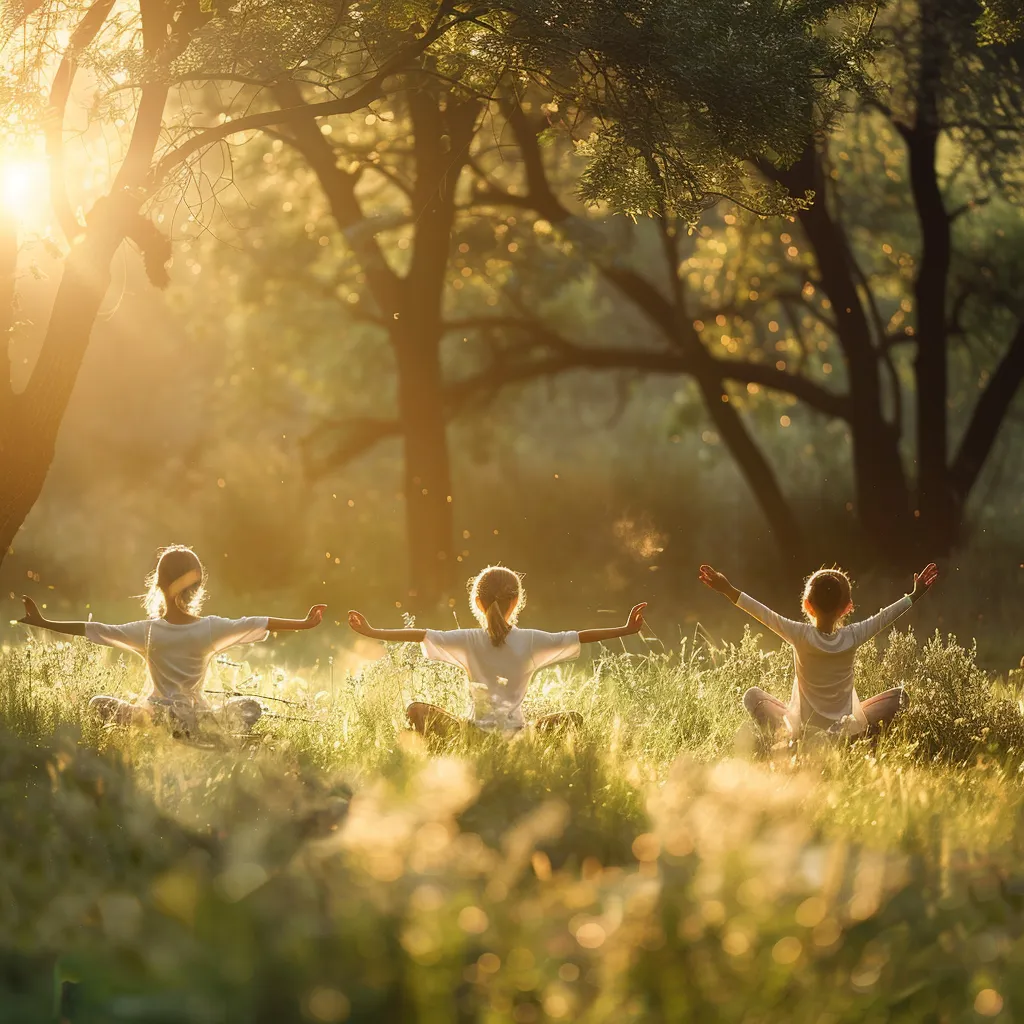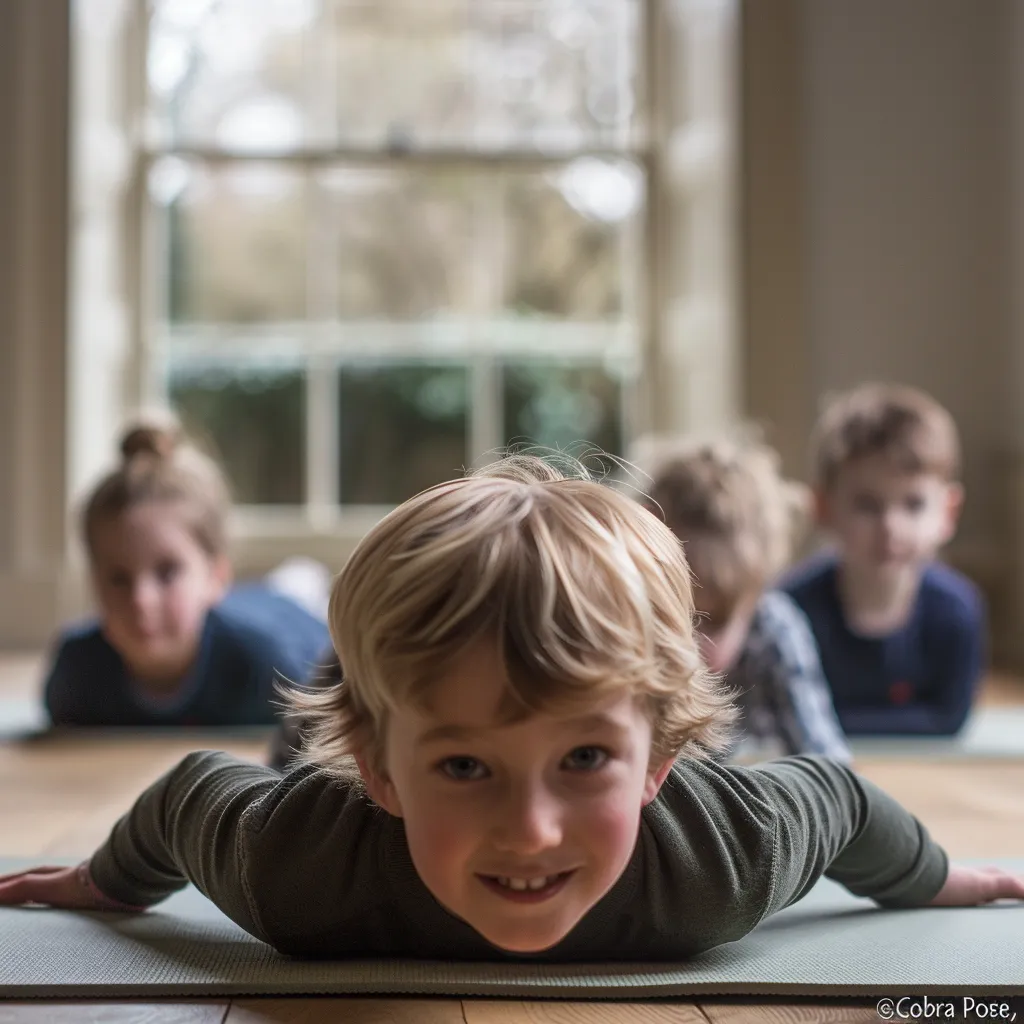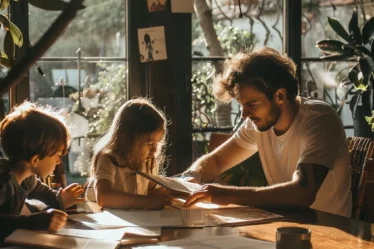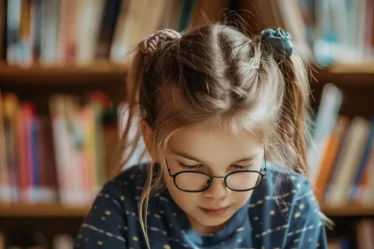
Yoga for children combines movement, play, and focus. Unlike adult yoga, it’s designed to be fun, with poses and games that help kids relax, build strength, and improve focus.
Yoga for children supports healthy bodies and calm minds, creating a strong foundation for growth and learning. In this guide, you’ll discover the basics, benefits, and tips for introducing yoga to kids.
What is Children’s Yoga
Children’s yoga adapts traditional yoga practices to fit children’s energy, creativity, and developmental needs. Rather than focusing on precision, children’s yoga emphasizes exploration, imagination, and playfulness. This approach makes it engaging and accessible for kids, offering physical and mental benefits in a relaxed environment.
Using Imagination to Keep Kids Engaged
Children’s yoga often incorporates storytelling, playful names, and animal actions to hold kids’ attention.
For example, poses like “Dog Pose” or “Butterfly Pose” may involve barking or flapping “wings” to make the movements feel like play. Adding sound effects, such as a hiss in “Cobra Pose” or a roar in “Lion Pose,” makes the session more interactive and fun.
These elements help children stay engaged and more likely to remember the poses because they connect them to familiar actions and stories.
Adapting Yoga Poses for Comfort
Children’s yoga focuses on safe and comfortable poses for young bodies. Movements are generally simple and low-impact, which helps kids build strength and flexibility without straining their muscles.
Instructors often avoid complex or intense poses and choose options that suit a child’s natural range of motion. Poses like “Cat-Cow” are gentle on joints and encourage children to stretch and move safely, giving them a healthy introduction to physical activity.
Encouraging Creativity and Exploration
Children’s yoga invites kids to explore movement freely rather than aiming for perfect alignment. By allowing children to modify poses in ways that feel natural, yoga promotes self-confidence and a sense of ownership over their practice.
Kids learn to connect with their bodies at their own pace, discovering what feels good and building body awareness in an encouraging space.
Using Simple Instructions and Visual Cues
To make yoga accessible, instructors or parents use clear, simple language and often demonstrate each pose first.
Children learn best by watching, so modeling the poses helps them easily follow along. Visual cues, like showing kids how to stretch their arms like tree branches or balance like a flamingo, create easy-to-follow instructions without overwhelming kids with complex terms.
Keeping Sessions Short and Focused
Children’s attention spans vary, so children’s yoga sessions are usually shorter than adult classes. Sessions often last around 15–30 minutes, allowing kids to enjoy the practice without losing focus.
Breaking up the session with short activities or changing poses frequently can help maintain children’s interest and energy levels.
Focusing on Fun, Not Perfection
Children’s yoga creates a relaxed, non-competitive environment where kids can enjoy moving their bodies.
Unlike adult yoga, which may focus on achieving precise forms, children’s yoga encourages kids to enjoy the process without worrying about “getting it right.”
This approach lets children feel comfortable and at ease, making it easier for them to enjoy the benefits of yoga.
Tips for Practicing Yoga with Children
- Choose Simple Poses: Start with easy poses like “Mountain Pose” or “Child’s Pose” to help children get comfortable. Gradually introduce more playful options as they build confidence.
- Use Props and Visuals: Yoga cards, books, or pictures can help kids understand poses without extensive instructions.
- Encourage Breaks: Allow children to rest or shake out their energy between poses to keep them interested.
- End with Relaxation: Closing with a few deep breaths or a short relaxation exercise helps children wind down, creating a calm transition from activity to rest.
Children’s yoga allows kids to enjoy movement in a supportive, fun environment. With creative poses, simple guidance, and a focus on enjoyment, children’s yoga provides a foundation for physical activity and mindfulness without the pressure of structured routines.
What is Fairy Yoga for Children: Why Do Kids Love It?
Fairy yoga introduces children to yoga through stories and imagination. Fantasy themes, characters, and playful scenes make each session an adventure. Kids don’t just follow poses; they step into roles like “fairy warriors,” “magical trees,” or “flying butterflies,” bringing the story to life with each movement.
In each session, children meet characters, solve simple challenges, or journey through magical lands. Storytelling keeps them engaged by blending movement with imagination. Naming poses after familiar fantasy elements make it easy for kids to follow along and enjoy.
The creative structure of fairy yoga keeps kids interested and active, offering an alternative to typical exercise routines. Children move freely, build strength, and focus on breathing without rigid expectations.
Fairy yoga gives kids a fun, safe space to explore, build new skills, and enjoy yoga as a playful, imaginative experience.
If you’re looking to improve study habits, our blog on how to learn efficiently has some great tips. We also discuss the pros and cons of online learning and provide an honest look at homeschooling benefits and challenges. You can find all these and more in our learning tips section.
8 Benefits of Yoga for Children’s Bodies and Minds
1. Build Focus and Attention with Kids’ Yoga
Yoga helps children develop concentration. Each pose encourages kids to focus on their bodies, breathing, and movements.
Regular practice teaches them to focus on one task at a time, strengthening their attention span. This focus benefits their schoolwork and daily activities.
2. Achieve Emotional Balance Through Yoga for Children
Yoga gives children tools to manage emotions. Breathing exercises and poses encourage kids to pause and recognize their feelings.
Learning to slow down and take deep breaths builds emotional awareness, which helps them handle frustration or excitement calmly.
3. Develop Balance and Coordination with Yoga Poses
Yoga poses like Tree Pose and Warrior Pose improve balance and coordination. Children learn to stabilize their bodies and develop control.
Better balance and coordination enhance their performance in sports, playground activities, and daily movements, boosting their physical confidence.
4. Increase Flexibility and Strength in Yoga for Kids
Yoga strengthens and stretches different muscle groups, supporting flexibility and core strength.
Poses like Downward Dog and Cat-Cow build flexibility and strength, allowing kids to move easily and avoid injuries. This foundation of strength supports healthy physical growth.
5. Cultivate Calm with Yoga Breathing Techniques
Yoga teaches children calming breathing exercises that relax body and mind. Deep, slow breaths help kids reduce stress and feel centered.
These techniques help children find calm when they feel anxious or overwhelmed.
6. Build Confidence and Self-Esteem Through Yoga
Yoga encourages children to feel proud of their abilities. Each pose or sequence they master boosts their confidence in their skills.
Yoga practice reinforces self-belief, showing kids they can achieve their goals with patience and effort.
7. Strengthen Social Skills with Group Yoga Activities
Yoga often involves teamwork, which builds social skills. Partner poses, and group exercises encourage cooperation, patience, and kindness.
These social interactions foster empathy and teamwork, supporting friendships and positive relationships.
8. Boost Mental Well-being and Positivity with Yoga
Yoga nurtures children’s mental health along with physical strength.
Practicing mindfulness during yoga teaches kids to be aware of thoughts and feelings without judgment, which reduces anxiety and supports a positive mindset.
Practical Tips for Practicing Yoga with Children
Practicing yoga with children at home can be a rewarding and engaging experience. Here are practical tips to make yoga sessions enjoyable and accessible for kids, building a foundation for mindfulness and movement.
Create a Comfortable, Relaxed Yoga Space
Set up a quiet, open area free from distractions. Lay out a yoga mat or a soft surface, and encourage your child to move freely. Creating a calm, relaxed space helps children focus and feel comfortable exploring new yoga poses and movements.
Keep Yoga Sessions Short and Fun
Children respond best to shorter, playful sessions. Start with 10-15 minutes, incorporating fun poses that resemble animals or nature, like “Cat Pose” or “Tree Pose.” Engaging children’s imagination makes yoga feel like play rather than a structured activity, encouraging them to return for more.
Encourage Creativity and Exploration in Yoga Poses
Let children experiment with different poses, adapting them in natural ways. Children’s yoga is not about perfect alignment but exploring movement and balance at their own pace. Encouraging creativity builds confidence and makes yoga enjoyable.
Use Simple Language and Demonstrate Each Pose
Avoid complicated instructions. Instead, demonstrate each pose yourself. Children learn by watching and imitating, so clear, simple guidance helps them feel comfortable trying new movements in a supportive environment.
Finish with Relaxation and Breathing Exercises
End each session with gentle breathing exercises or a few moments of quiet relaxation. Deep breathing or a brief “quiet time” helps children experience the calming effects of yoga, grounding them after active movement.
Following these tips can make practicing yoga with children at home a fun, peaceful, and beneficial experience for you and your child.
Bring the Benefits of Yoga into Your Child’s Life
Adding yoga to a child’s routine supports both physical and mental well-being. Simple yoga sessions teach children to relax, focus, and build physical strength. Short, playful sessions fit easily into daily life, making yoga feel natural and fun.
Parents and educators can start with basic poses and breathing exercises, encouraging children to explore movement comfortably. Practicing together as a family or in a group creates a positive space where kids feel excited to join. A few minutes a day can help children develop calm, focus, and physical fitness.
Bringing yoga into your child’s life builds healthy habits and strengthens connections at home and school.
Looking for a yoga class for kids? Try searching online for terms like “yoga for children” or “children’s yoga teacher.” For example, you might look up “yoga for children Liverpool” or “yoga for children Manchester.” Other search terms, such as “fairy yoga for kids London” or “kids yoga Birmingham”, can also be helpful. You can also use the meet’n’learn platform to quickly find a yoga course or teacher for children.
Yoga for Children: Frequently Asked Questions
1. What is yoga for children?
Yoga for children is a playful form of yoga designed to teach kids simple poses and breathing exercises.
2. How is children’s yoga different from adult yoga?
Children’s yoga uses storytelling, games, and imaginative names to make poses fun and engaging.
3. At what age can children start practicing yoga?
Children as young as three can start practicing yoga with age-appropriate poses and activities.
4. What are the main benefits of yoga for children?
Yoga helps children develop focus, flexibility, strength, and emotional balance.
5. How long should a children’s yoga session be?
Sessions are typically 15–30 minutes to match children’s attention spans and energy levels.
6. Is children’s yoga safe for all kids?
Yes, children’s yoga is low-impact and designed to be safe, though supervision is recommended.
7. Can parents and teachers practice yoga with children?
Absolutely—yoga can be a shared activity that strengthens bonds and makes learning fun.
8. Do children need special equipment for yoga?
No, a simple mat or soft surface is enough to get started with children’s yoga.
References:
1. Action For Healthy Kids
2. Eden Academy
3. Wikipedia



